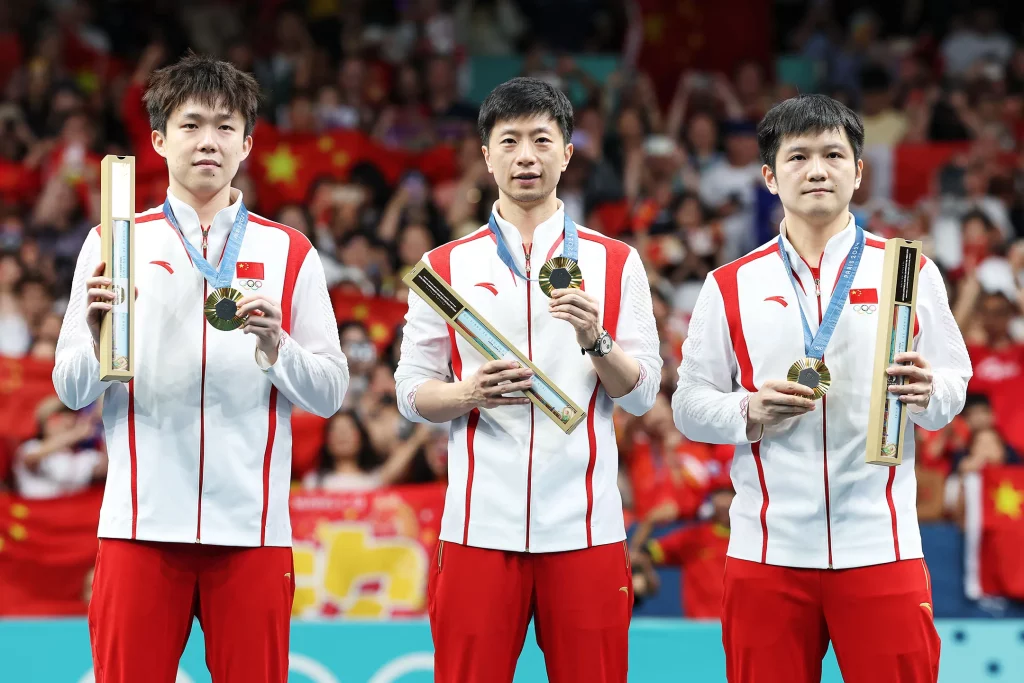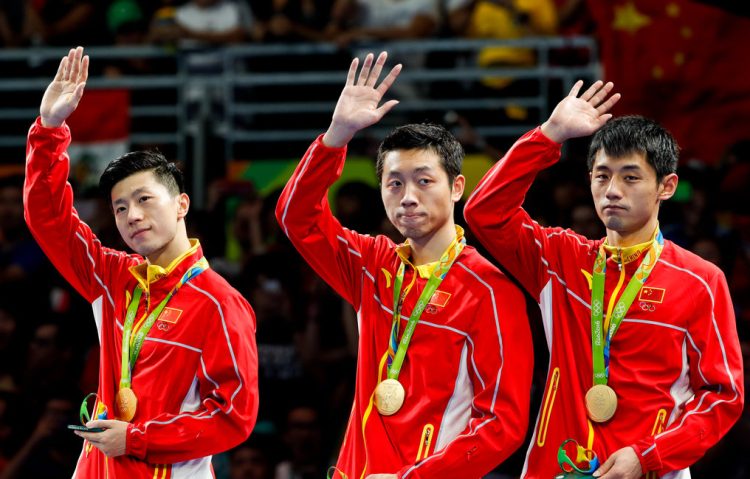Table tennis has long been a sport where China has dominated the international scene, establishing itself as a powerhouse in every major competition. From World Championships to Olympic Games, Chinese players have consistently been at the top of the rankings, delivering exceptional performances year after year. However, as the sport evolves, new challenges have emerged. In recent years, countries like Japan and Germany have made significant strides in closing the gap with the Chinese, producing top-level players who are becoming increasingly competitive on the global stage. This raises an important question: Can China’s table tennis players continue to maintain their technical superiority against the rising forces of Japan and Germany?
In this article, we will explore the technical advantages that Chinese table tennis players have historically held, examine the recent progress made by Japanese and German players, and analyze how China’s current crop of talent might adapt to the growing challenges they face from these emerging table tennis nations.
1. The Technical Superiority of Chinese Table Tennis Players
China has long been regarded as the global leader in table tennis due to its systematic approach to player development, rigorous training methods, and emphasis on technical precision. The country’s dominance is rooted in several key aspects of its players’ technical capabilities:
A. Footwork and Agility
Chinese players are renowned for their exceptional footwork and agility. Their ability to move quickly around the table and position themselves optimally for each shot is unmatched. This ability to adapt to different playing styles and to counterattack with precision has been a hallmark of Chinese table tennis. Whether it’s an aggressive forehand loop or a precise backhand flick, the quickness of movement allows them to set up for shots effectively, dictating the pace of the game.
B. Serving and Return of Serve
Serving and returning serves are two critical elements of modern table tennis, and Chinese players have honed their skills in both areas. The ability to serve with spin, speed, and deception is something that Chinese players have perfected over the years. Their short serves, combined with heavy side-spin and under-spin, make it difficult for opponents to anticipate the ball’s trajectory and return it effectively. In return, Chinese players are also incredibly adept at reading the opponent’s serve and placing the ball in vulnerable positions with a variety of spin-based returns.
C. Speed and Power
Chinese table tennis players are often characterized by their blend of speed and power. The sport has evolved from a primarily tactical game into one where raw power and explosive speed play an increasing role. Chinese players are experts at using their athleticism to produce high-speed loops that are difficult to counter. This combination of speed and power allows Chinese players to dictate rallies, putting their opponents under constant pressure and forcing errors.
D. Mental Toughness and Consistency
Beyond physical ability, Chinese table tennis players also exhibit remarkable mental toughness and consistency. Their ability to maintain focus during long rallies and in high-pressure situations has been a key factor in their dominance. Whether in the heat of a World Championship final or during an Olympic gold medal match, Chinese players have consistently displayed the ability to perform under immense pressure, showcasing their mental resilience as a critical part of their technical game.
E. All-Round Game Strategy
One of the reasons why Chinese players dominate is their ability to play a complete game. They are capable of adapting their strategy during matches, making adjustments to their playing style to exploit their opponent’s weaknesses. Whether it’s transitioning between defensive and offensive play or adapting their game to counter different types of spins, Chinese players are known for their versatility and tactical intelligence.
2. The Rise of Japanese Table Tennis: New Threats to China’s Dominance
In recent years, Japan has emerged as a formidable contender in international table tennis. While China remains the dominant force, Japan has been closing the gap and producing world-class players capable of competing with the best. Some key factors that have fueled Japan’s rise are:
A. A New Generation of Talent
Japan has produced a new generation of young table tennis players, including Tomokazu Harimoto, Mima Ito, and Hina Hayata, who are making waves on the international stage. Harimoto, in particular, has been a standout, becoming one of the youngest-ever players to reach the top rankings in the world. His aggressive and fast-paced style, combined with his ability to adapt and read his opponents, has made him a top contender in major tournaments. Mima Ito, with her exceptional backhand and quick reflexes, has been a major force in the women’s game.
B. Playing Style and Aggression
Japanese players are often praised for their aggressive playing style and their ability to create sharp, fast attacks from almost any position on the table. They are known for counter-attacking and finishing points quickly—often with explosive forehands or quick backhand flicks. This high-energy, fast-paced style of play has given Japanese players an edge in certain matchups, particularly when they play against opponents who prefer a more defensive, controlled approach.
C. Technical Innovation and Precision
Japanese players have also brought a level of technical innovation that has challenged traditional styles. Players like Ito have demonstrated mastery in areas such as chopping and short play, combining their skills with the ability to control the ball precisely. Their technical execution—combined with incredible reflexes—has put pressure on Chinese players, particularly in areas like serving and returning, where Japanese players have been able to innovate and adapt faster than before.
D. Mental Resilience and Focus
Japanese players have displayed remarkable mental toughness in recent years, which has allowed them to perform consistently at the highest level. Players like Harimoto are known for their focus and ability to execute under pressure, which has made them formidable in both team and individual competitions.
Despite these advancements, Japan has still struggled to match China’s overall consistency and depth. While individual players like Harimoto and Ito are top contenders, Japan lacks the sheer number of elite players that China has been able to develop over the years. This remains one of the key factors that separates the two countries in the table tennis hierarchy.
3. The Rise of Germany: Europe’s Powerhouse
Germany has also emerged as a strong competitor in the global table tennis scene, especially through the consistent performances of players like Timo Boll, Dimitrij Ovtcharov, and Patrick Franziska. Germany’s rise has been marked by the following key factors:
A. Consistent Performers at the Highest Level
Timo Boll, who has been a key figure in German table tennis for over a decade, has remained a top competitor in international events, consistently challenging for podium finishes at the World Championships and Olympic Games. Boll’s game is built on a blend of precise, controlled play, paired with powerful, sharp strokes that make him difficult to beat in both singles and doubles competitions.
Similarly, Dimitrij Ovtcharov has established himself as one of the premier players in the men’s game, known for his incredible athleticism and ability to execute powerful counter-hits under pressure. These players, along with the rising talents from Germany, have made the European nation a consistent threat in the sport.
B. Defensive and Tactical Play
One of the characteristics of German table tennis is their focus on defensive play and tactical discipline. German players are often known for their ability to endure long rallies and maintain a high level of consistency over extended matches. While they may not have the sheer explosive power of Chinese players, their emphasis on grinding out points and building rallies gives them an advantage in certain matchups.
C. The Strategic Use of Equipment
German players are also known for their strategic approach to equipment. The preference for certain types of rubbers, combined with a keen understanding of how to use them in different playing conditions, has allowed German players to create unique playing styles that can counter Chinese strategies. The effective use of anti-spin rubbers or long pimples has provided them with an edge in specific situations.

4. How Will China Respond?
With Japan and Germany continuing to improve and challenge the status quo, the question remains: How will China respond?
A. Embracing Adaptation
China’s success has always been rooted in its ability to adapt. Over the years, the Chinese have constantly tweaked their techniques to stay ahead of their competitors. While Japan and Germany have made significant advancements, Chinese players like Fan Zhendong and Ma Long have shown that they are still capable of dominating with their superior technical skills, particularly in areas like speed, precision, and mental resilience.
B. Developing New Stars
China’s approach to developing new talent is another factor that will help them maintain their dominance. The Chinese Table Tennis Association continues to invest heavily in grassroots programs, identifying young talent and nurturing them to the highest levels. As Japan and Germany produce standout players, China is ensuring that its pipeline remains full, with future stars like Wang Chuqin and Sun Yingsha already making waves.
C. Strategic Adjustments
China may also start to incorporate some of the innovations seen from Japan and Germany. With the rise of aggressive counter-attacking and the strategic use of equipment, China may look to incorporate these strategies into their training regimes, ensuring that their players remain adaptable and versatile in high-level international competition.
5. Conclusion: Will China’s Technical Superiority Prevail?
While Japan and Germany have made significant strides in closing the gap with China in table tennis, China’s technical superiority, combined with its deep pool of talent and ability to innovate, suggests that it will continue to be a dominant force in international competitions. However, the rise of these nations will undoubtedly push China to refine its strategies, adapt its techniques, and continue to develop new generations of players to maintain its status as the global leader in table tennis.
The future of international table tennis will be exciting, with fierce competition from multiple countries, but China’s technical mastery and ability to adapt will likely keep them at the top for years to come.


































Discussion about this post